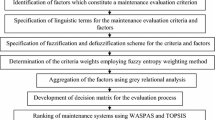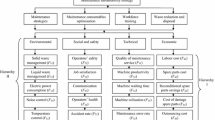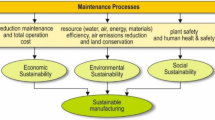Abstract
Operational performance of a plant and its competitiveness are dependent on reliability and maintainability of its equipment, which in turn are dependent on how these are designed and how effectively the maintenance activities are carried out. This paper proposes an integrated approach based on graph theory, interpretive structural modelling (ISM) and matrix method to quantitatively evaluate the maintenance performance leading to a numerical index, called as maintenance performance index (IMP). The approach is premised based on the fact that, the effectiveness of maintenance performance is a complex interaction of various factors prevailing in the plant. The index evaluates the maintenance performance by assessment of the individual maintenance functions, which the system is expected to fulfil. IMP is obtained from the Maintenance Performance Matrix by substituting the performance index, (IFP), of the individual maintenance functions and maintenance function’s interdependence values. Performance index of each individual maintenance function is obtained from the corresponding Function Performance Matrix, by substituting indicator characteristic values and indicator causal interrelationship values. This matrix is obtained by extracting the relationships among the indicators using the ISM approach. The ISM presents a hierarchy based model of the interrelated indicators and their significance in the measurement of maintenance performance. The methodology is demonstrated using a case study. The approach is premised based on the fact that, the effectiveness of maintenance performance is a complex interaction of various factors prevailing in the plant. The suggested methodology is convenient for the industry to hierarchically classify both subjective and objective performance parameters and in quantifying maintenance performance.














Similar content being viewed by others
References
Al-Najjar B, Hansson M, Sunnegardh P (2004) Benchmarking of maintenance performance: a case study in two manufacturers of furniture. IMA J Manag Math 15(3):253–270
Attri R, Grover S, Dev N, Kumar D (2013) An ISM approach for modelling the enablers in the implementation of total productive maintenance (TPM). Int J Syst Assur Eng Manag 4(4):313–326
Bakhtiar A, Purwanggono B, Metasar N (2009) Maintenance function’s performance evaluation using adapted balanced scorecard model. World Acad Sci Eng Technol 58:548–552
Ben-Daya M, Duffuaa SO, Raouf A, Knezevic J, Ait-Kadi D (2009) Handbook of maintenance management and engineering. Springer, London
BS EN 15341: 2007 Maintenance (2007) Maintenance key performance indicators. European Committee for Standardization (CEN), Brussels
Campbell JD (1995) Uptime: strategies for excellence in maintenance management. Productivity Press, Portland
CEN (2001) Maintenance terminology. European Committee for Standardization EN 13306, Brussels
Coetzee JL (1998) Maintenance. Maintenance Publishers, Hatfield
EEA (European Environmental Agency). (1999). Environmental indicators: typology and overview. Technical report no. 25, Copenhagen (Denmark)
Gulati R, Smith R (2009) Maintenance and reliability best practices. Industrial Press Inc., NewYork, p 10018
Gupta P, Gupta S, Gandhi OP (2013) Modeling and evaluation of MTTR at product design stage based on contextual criteria. J Eng Des 24(7):499–523
Gupta S, Kota S, Mishra RP (2015) Modeling and evaluation of product quality at conceptual design stage. Int J Syst Assur Eng Manag 7(1):163–177
Henley EJ, Williams RA (1973) Graph theory in modern engineering. Academic Press, New York
Hibi S (1977) The Hibi maintenance system. Nordica Int. Limited for Asian Productivity Organization, Tokyo
Jurkat WB, Ryser HJ (1966) Matrix factorization of determinants and permanents. J Algebra 3(1):1–27
Kaplan RS, Norton DP (2005) The balanced scorecard-measures that drive performance. Harv Bus Rev 83(7):172
Komonen K (2002) A cost model of industrial maintenance for profitability analysis and benchmarking. Int J Prod Econ 79(1):15–31
Kumar U, Ellingsen HP (2000) Development and implementation of maintenance performance indicators for the Norwegian oil and gas industry. In: Proceedings of the 15th European maintenance conference (Euromaintenance 2000), Gothenburg, Sweden, March 2000, pp 221–228
Kumar P, Singh RK, Kumar R (2017) An integrated framework of interpretive structural modeling and graph theory matrix approach to fix the agility index of an automobile manufacturing organization. Int J Syst Assur Eng Manag 8(Suppl 1):342–352
Kutucuoglu KY, Hamali J, Irani J, Sharp JM (2001) A framework for managing maintenance using performance measurement systems. Int J Oper Prod Manag 21(1/2):173–194
Kutucouglu KY, Hamali J, Sharp JM, Irani Z (2002) Enabling BPR in maintenance through a performance measurement system framework. Int J Flex Manuf Syst 14(1):33–52
Levitt J (2009) The handbook of maintenance management, 2nd edn. Industrial Press Inc, New York
Liyanage JP, Kumar U (2003) Towards a value based view on operations and maintenance performance management. J Qual Maint Eng 9(4):333–350
Luck WS (1956) Now you can really measure maintenance performance. Fact Manag Maint 114(1):81–86
Manoharan TR, Muralidharan C, Deshmukh SG (2010) Analyzing the interaction of performance appraisal factors using interpretive structural modelling. Perform Improv 49(6):25–35
Martorell S, Sanchez A, Munoz A, Pitarch JL, Serradell V, Roldan J (1999) The use of maintenance indicators to evaluate the effects of maintenance programs on NPP performance and safety. Reliab Eng Syst Saf 65(2):85–94
Mather D (2005) The maintenance scorecard—creating strategic advantage. Industrial Press Inc, New York
Muchiri PN, Pintelon L, Martin H, De Meyer AM (2010) Empirical analysis of maintenance performance measurement in Belgian industries. Int J Prod Res 48(20):5905–5924
Muchiri PN, Pintelon L, Gelders L, Martin H (2011) Development of maintenance function performance measurement framework and indicators. Int J Prod Econ 131(1):295–302
Neely AD, Gregory M, Platts K (1995) Performance measurement system design—a literature review and research Agenda. Int J Oper Prod Manag 15(4):80–116
Parida A (2007) Study and analysis of maintenance performance indicators (MPIs) for LKAB. J Qual Maint Eng 13(4):325–337
Parida A (2008) Maintenance performance assessment framework for engineering asset. In: Proceedings of the 2008 IEEE IEEM, pp 1351–1354
Parida A, Chattopadhyay G (2007) Development of a multi-criteria framework for maintenance performance measurement. J Qual Maint Eng 13(3):241–258
Parida A, Kumar U (2006) Maintenance performance measurement: issues and challenges. J Qual Maint Eng 12(3):239–251
Parida A, Chattopadhyay G, Kumar U (2005) Multi criteria maintenance performance measurement: a conceptual model. In: Proceedings of the 18th international congress of COMADEM, 31st August–2nd September, Cranfield, pp 349–356
Pati D, Park CS, Augenbroe G (2010) Facility maintenance performance perspective to target strategic organizational objectives. In: Journal of performance of constructed facilities, ACSE, March/April, pp 180–187
Pintelon L, Puyvelde FV (1997) Maintenance performance reporting systems: some experiences. J Qual Maint Eng 13(1):4–15
Priel VZ (1962) 20 ways to track maintenance performance in factory. McGraw Hill Book Company Inc, New York, pp 88–91
Raouf A (1994) Improving capital productivity through maintenance. Int J Oper Prod Manag 14(7):44–52
Sharp JM, Irani Z, Wyant T, Firth N (1997) TQM in maintenance to improve manufacturing performance. In: Proceedings of PICMET conference, Portland, OH, USA
Smith R, Mobley RK (2008) Rules of thumb for maintenance and reliability engineers. Butterworth-Heinemann, Waltham
Stricoff R (2000) Safety performance measurement; identifying prospective indicators with high validity. Prof Saf 45(1):36–39
Thompson G, Nilsson C (2001) A multi-objective approach to design for reliability. Proc Inst Mech Eng Part E. 215:197–205
Tsang AHC (1998) A strategic approach to managing maintenance performance. J Qual Maint Eng 4(2):87–94
Tsang AHC, Jardine AKS, Kolodny H (1999) Measuring maintenance performance: a holistic approach. Int J Oper Prod Manag 19(7):691–715
Vaisnys P, Contri P, Rieg C, Bieth M (2006) Monitoring the effectiveness of maintenance programs through the use of performance indicators. DG JRC-Institute for Energy
Wani MF, Gandhi OP (1999) Development of maintainability index for mechanical systems. Reliab Eng Syst Saf 65(3):259–270
Weber A, Thomas R (2005) Key performance indicators—measuring and managing the maintenance function. Ivara Corporation, Ontario
Wilson A (2002) Asset maintenance management—a guide to developing strategy and improving performance. Industrial Press Inc, New York
Wireman T (1998) Developing performance indicators for managing maintenance. Industrial Press Inc, New York
Author information
Authors and Affiliations
Corresponding author
Additional information
Deceased: O. P. Gandhi.
Rights and permissions
About this article
Cite this article
Aju kumar, V.N., Gupta, P. & Gandhi, O.P. Maintenance performance evaluation using an integrated approach of graph theory, ISM and matrix method. Int J Syst Assur Eng Manag 10, 57–82 (2019). https://doi.org/10.1007/s13198-018-0753-6
Received:
Published:
Issue Date:
DOI: https://doi.org/10.1007/s13198-018-0753-6




